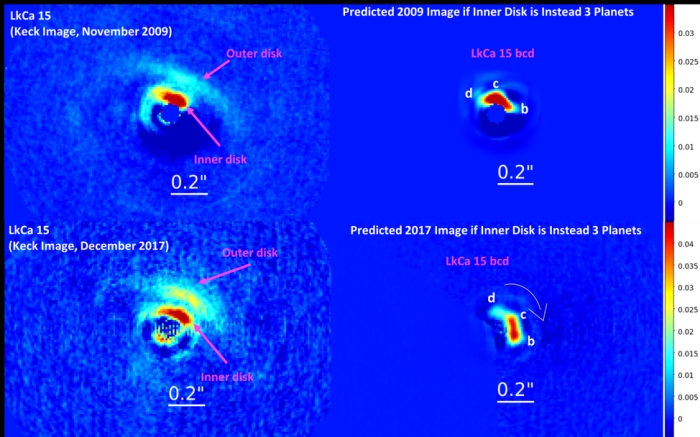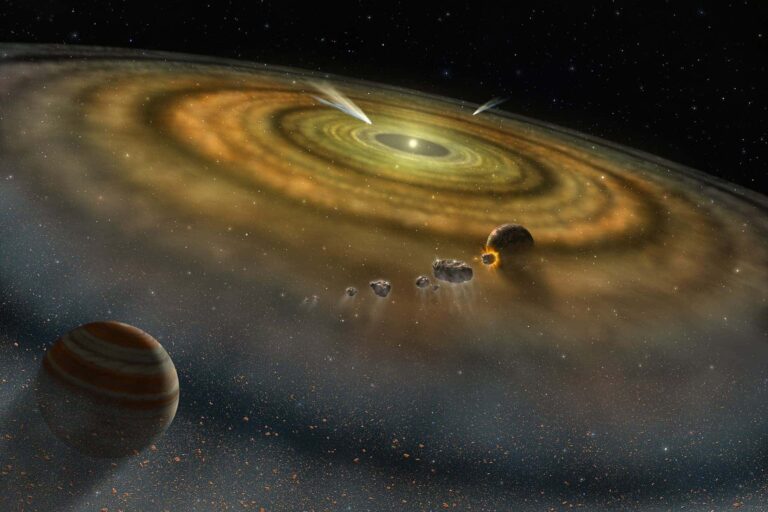The clear images of a distant planetary system, displaying three planets, have disappeared.
Astronomers in Hawaii have accomplished one running through a success of two telescopes. Their survey instruments were able to penetrate an obscuring veil surrounding a young star that is more than 473 light-years away, instructively called the LkCa 15. For the first time ever, an exoplanetary atmosphere was successfully detected, marking the discovery of a protoplanetary disc – a spinning region where planets’ developmental stages are still evolving.
As the earlier studies only indicated that the trio may possess several large planets, the latest ones now throws in more questions because of their contradictory findings. However, being without failing it not mean a planetry isn’t existed. In fact, the exists a significant development through to the detection techniques that are being demonstrates. The above progress happens as a consequence of which, deeper insights into the case on how planets emerge are obtained.
Imagine a celestial nursery. Infants of the star are hidden in the clouds of gas and dust at the center of a rotating disc of elements such as rock bits. Over millions of years, others get into contact with them forming planetary accretion. Gravity, indeed, the central figure of the entire cosmic process, captures more and more materials until a completed planet emerges from this process, its own orbit now clear.
Spectacular photos of such discs, with detritus markings swirled in, have been taken from earthly space telescopes even though they cannot be observed directly. In fact, astronomers before thought they had discovered in the system of LkCa15 three huge planets, each one more powerful than the Jupiter, whose size was comparable to the one of Saturn, orbiting in a gap far as our Solar System. Here it was realized by sparse aperture masking interferometry technique that was aimed at the separation of the stellar host the wobbly tiny light of the planet.
Nevertheless, by taking the advantage of sub-components of the Subaru Telescope and the W M Keck Observatory, but a worldwide team of researchers has reveled the most unexpected turn. With that, the earlier representation of planets’ light sources was thought to come from the accretion disc itself.

“The detail of LRc 15 is wonderfully complex!” declared Dr. Thane Curry, astrophysicist with the NASA-Ames Research Center and Subaru Telescope. “After the analysis of data from Keck and Subaru, even we would have presumed that there were three super-Jupiter planets preceding the other findings,” concluded the investigators.
Detailed investigation conducted during the last investigation. The Subaru Telescope’s most advanced instrument, the Subaru Coronagraphic Extreme Adaptive Optics (SCExAO), provides images of the disc in near-infrared light alongside with Coronagraphic High Angular Resolution Imaging Spectrograph (CHARIS). It is important to note that NIRC2, which is the near-infrared camera of the Keck Observatory, instead observed the system at longer wavelengths, which are specific to young planets. Furthermore, the study dug up NIRC2 images of the system that were taken in 2009 and included in the archives. These class A data sets would be used for comparison.
Finally it was the overall analysis strategy, taking into account both newly collected and existent data, that led to the revealing of an important fact. The dominating source of the LkCa 15 disk’s light was its arc-shaped edge, which was distinguishable in the observed brightness. It had previously been erroneously identified as those massive planets’ fingerprint on the scene.
This, though, does not mean that there could not be any planets’ existence at all with non existence of confirmed giant planets. The research team postulates the possibility of these large, faint planets that are the same size as Jupiter or Saturn or could even be smaller than that to be embedded within the disc. If only these exoplanets succeed to be spotted, there is an unequaled chance to unravel diverse mysteries of planet formation, rather with a reference to the whole universe but to our home system.
“The apparently developing planets in the solar system might not be that different from our own one,” Dr. Currie accidently agreed. “They probably exist, just hiding inside the disc.”The search continues.”
Do not forget to share your opinion with us to provide you with the best posts !




0 Comments